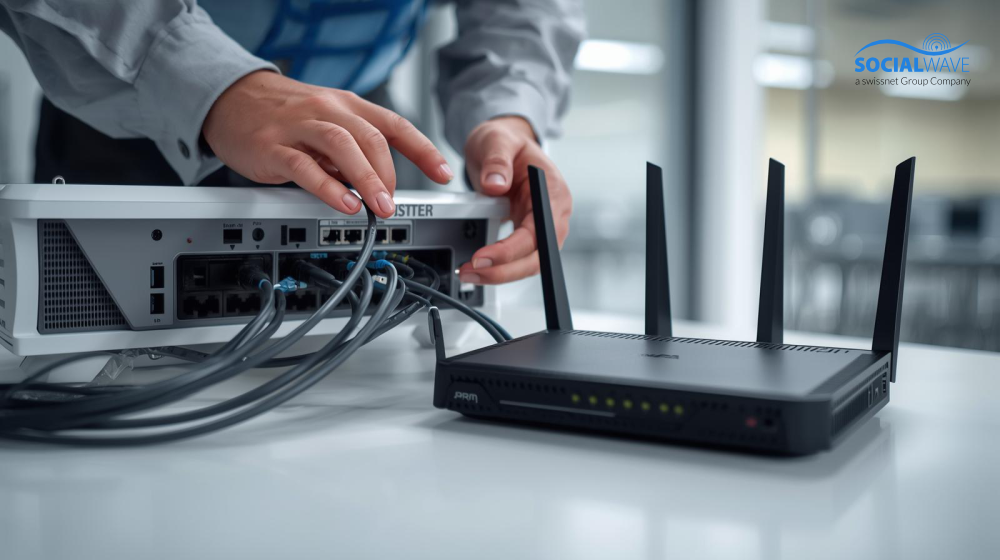Empty 5G hype? — Why WiFi still remains relevant

The large-scale introduction of 5G mobile networks was a huge leap in mobile network technology. Significantly higher transfer rates and low latency times open up completely new areas of application. It seems that WLAN and its use are becoming more and more in the background. But this impression is deceptive. Because there have also been major developments in this field recently. With Wi-Fi 6 in particular, new opportunities have been created that are in no way inferior to those that came with 5G. Entrepreneurs considering switching to the new mobile communications standard should therefore keep the most important differences in mind.
Comparing Wi-Fi 6 and 5G
In terms of speed, Wi-Fi 6 can easily keep up with 5G and even surpasses it, because 5G has a maximum transfer rate of 4 Gbps, Wi-Fi 6 even reaches almost 10 Gbps.
The compatibility of WLAN is also a major advantage compared to mobile Internet. Of course, devices must be relatively new to support the new standards. However, the routers that enable Wi-Fi 6 are easily backwards compatible with older devices. 5G, in contrast, cannot be used on old devices and radio masts must also be equipped for the older standards. In addition, other devices, such as computers or printers, cannot be easily switched over.
In addition to speed and compatibility, network administration can also be a problem. This is because with a mobile network, users are completely dependent on the mobile phone provider and there is no access to managing the Internet. In contrast, in a WLAN network, the provider has full access to administration. You can set time limits on network activity, create guest networks, and block or unblock devices.
Network security is also not as easy to set with mobile Internet as with WLAN. Your own firewalls can be used and managed there, and the Internet access of employees and guests is completely under your own control. 5G also does not have filters for malware and adult content.
WLAN continues to be a pioneer in the interior
If you want to connect a company or a company within a location, you simply cannot ignore the topic of WLAN. On the one hand, the infrastructure is usually already at least partially available, and on the other hand, a possible upgrade to the latest standard is not associated with such high costs as switching to the use of 5G.
5G also creates further obstacles within buildings. This is because access to the Internet is only possible through a connection to the radio tower, which can quickly be disrupted by walls, cables or other components of the building. Of course, WLAN can also be affected by the same factors, but here it is possible to expand and expand the network with hardware such as access points or repeaters.
With a Socialwave network, for example, the hardware is designed during planning so that the respective location can be optimally illuminated with WLAN. In contrast, 5G coverage cannot be optimised retrospectively.
5G is particularly important on mobile
Even though 5G will not replace indoor WiFi, it still enables a variety of new technologies that depend on fast and, above all, extensive Internet access.
In the automotive sector in particular, the benefits of 5G are becoming apparent, as self-driving vehicles, which must communicate in real time and process data, depend on a fast connection.
But geographically separated production sites or smart cities also benefit from the new mobile radio standard, as WLAN can no longer be used efficiently over longer distances.

Make optimal use of WiFi with Socialwave
If you need Internet to connect a location, offer guests a network or do marketing, then WLAN, especially with the new Wi-Fi 6 standard, is the right choice. Then the only question that remains is how to set up and manage the WiFi network correctly. And that's where Socialwave comes in.
Because with a guest WiFi from Socialwave, you have enormous benefits and reduced effort. This allows you to automate many of the daily administrative tasks as well as the associated marketing functions. In addition, our specially developed operating system and firewall ensure the security and reliability of the network at all times. You and your customers are also protected against misuse and compliance with the GDPR guidelines is observed right from the start.
conclusion
5G was an enormously important development in the area of mobile network technology and made many new technologies possible. Nevertheless, it cannot cover every area of application and will therefore not be able to replace WLAN in the foreseeable future. Especially indoors, WLAN offers flexibility and access that 5G does not have.
If you then combine WLAN in this application with a complete system such as Socialwave, with reduced effort, you have a variety of options that can offer many advantages for a company. Find out more here.








.svg)

.svg)
.svg)



